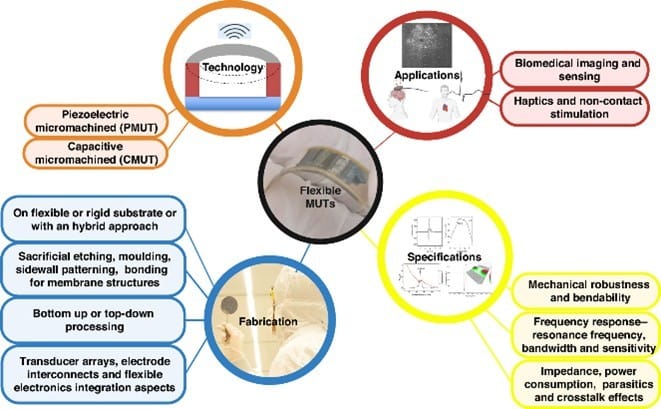Flexible ultrasound transducers introduce the ability to conform to curved surfaces like the human body.
Ultrasound technology is a cornerstone of medical imaging, commonly using rigid probes that rely on piezoelectric vibration in their thickness mode. While effective, these probes have limitations due to their fabrication methods, such as mechanical dicing.
To overcome these challenges, micromachined alternatives like piezoelectric micromachined ultrasonic transducers (PMUTs) and capacitive micromachined ultrasonic transducers (CMUTs) have been developed. These devices offer advantages such as smaller size, lower power consumption, compatibility with complementary metal oxide semiconductor electronics, and efficient batch manufacturing.
Parallelly, a new era of user-friendly alternatives is emerging with the advent of flexible sensor technology. Flexible ultrasound transducers take the microelectromechanical systems advancements further by introducing the ability to conform to curved surfaces like the human body. Consistent skin contact can reduce diagnostic errors and enhance the quality of results. This technology could obviate the need for experienced operators and operator-dependent variability, a requirement of traditional rigid probes used in traditional clinical settings.
However, key hurdles remain in achieving high-performance materials-stack design, developing reliable manufacturing processes, and ensuring seamless integration with existing medical systems. Overcoming these challenges is crucial for the widespread adoption of flexible micromachined ultrasound transducers (MUTs) in the biomedical field.
A Closer Look at Flexible MUTs
A research team from KU Leuven published a review in Microsystems & Nanoengineering, focusing on the development of flexible MUTs. The review offers an exploration of flexible MUTs, an emerging technology in biomedical diagnostics. The review paper discusses the need for flexibility in ultrasound transducers, highlighting potential applications and explores the potential of flexible PMUTs and CMUTs in meeting the evolving demands of biomedical research.
The authors then examine fabrication techniques for both piezoelectric (PMUT) and capacitive (CMUT) variants, detailing the innovative approaches that enable flexibility without much compromise on performance. The study compares key performance parameters such as resonance frequency, sensitivity, and flexibility, revealing the unique advantages of each type.
For example, PMUTs are known for their low-voltage operation, while CMUTs stand out for their ultra-high bandwidth capabilities. The research highlights the critical role of material selection and design optimization in achieving the desired performance characteristics. The article also addresses challenges in integrating these flexible devices with electronic systems, proposing solutions to overcome these obstacles.
This comprehensive analysis not only summarizes the current state of the field but also outlines future research directions needed to unlock the full potential of flexible MUTs in biomedical applications, providing valuable insights for researchers, engineers, and healthcare professionals.
Future Prospects for Flexible MUTs in Healthcare
“The emergence of flexible micromachined ultrasound transducers opens up interesting possibilities in biomedical ultrasound, for instance, the integration of flexible MUTs into everyday healthcare in the form of smart patches for remote patient monitoring,” says Sanjog Vilas Joshi, a PhD candidate at KU Leuven, Belgium, and one of the lead authors of the study, in a release. “However, achieving such pioneering goals requires addressing technical limitations, such as those outlined in the review. To achieve this, further investment in R&D on flexible MUT-based technologies is required.
“In the recent research domain of flexible ultrasound, bulk piezoelectric transducers have shown great promise with various demonstrated applications including wearable ultrasound imaging and continuous monitoring. On the other hand, flexible CMUTs are emerging demonstrating proof of concept for imaging. Flexible PMUTs remain the most recent one with significant optimization challenges.
“Nevertheless, with sustained research, flexible MUTs have the potential to close the gap with other mature ultrasound modalities and unlock new opportunities in wearable ultrasound to aid diagnostics and disease prevention.”
Photo caption: From technology and design-fabrication aspects to specifications and targeted applications
Photo credit: Microsystems & Nanoengineering
Summary:
Researchers are exploring flexible micromachined ultrasound transducers (MUTs) as a potential advancement in medical imaging, particularly for wearable and remote monitoring applications. Traditional ultrasound probes are rigid and limited by fabrication constraints, but flexible MUTs—including PMUTs and CMUTs—offer advantages such as improved skin contact, reduced operator dependency, and enhanced imaging accuracy. A recent review from KU Leuven, published in Microsystems & Nanoengineering, examines the design, fabrication, and performance of these transducers, comparing key features such as sensitivity, resonance frequency, and bandwidth. While flexible MUTs show promise, challenges remain in material selection, manufacturing reliability, and integration with medical systems. Researchers highlight the need for further investment in optimization and real-world applications, such as wearable ultrasound patches for continuous health monitoring.
Key Takeaways:
- Flexible Ultrasound Transducers Improve Skin Contact – Unlike traditional rigid probes, flexible MUTs conform to curved surfaces, which may enhance diagnostic accuracy and reduce variability caused by operator technique.
- PMUTs and CMUTs Offer Different Advantages – While PMUTs operate at low voltages, CMUTs provide ultra-high bandwidth, making material selection and design optimization crucial for performance.
- Engineering Challenges Must Be Addressed for Widespread Use – Researchers emphasize the need to improve fabrication reliability, integration with medical systems, and optimization for clinical applications before flexible ultrasound technology can be widely adopted.





